The LCGC Blog: Relating Analyte Properties to HPLC Column Selectivity – On the Road to Nirvana
As I’ve written previously, our Nirvana in HPLC column selection would be to enter the structures of our analytes and have a database tell us the column and mobile phase conditions that we should use to carry out the separation successfully. Although I know of several groups who are working on this, in practice we are still a long way from realizing this goal.
The proliferation of HPLC column stationary phases (over 700 phases, from the various manufacturers, are now available) makes it impossible to screen the whole selectivity landscape to choose the best phase for your separation. Therefore, most of us use various filters such as the academic literature, applications notes, experience, manufacturer’s recommendations, and so forth, to narrow down our choices. Many groups use a screening approach whereby several orthogonal column chemistries are tested with a number of eluent systems to highlight which column or mobile phase combinations may we worthy of taking forward for optimization, which can, if used properly, shorten the method development cycle.
As I’ve written previously, our Nirvana in HPLC column selection would be to enter the structures of our analytes and have a database tell us the column and mobile phase conditions that we should use to carry out the separation successfully. Although I know of several groups who are working on this, in practice we are still a long way from realizing this goal.
Various software for HPLC optimization exists which will help you to understand a separation and to optimize the conditions – which is very helpful indeed, but the primary driving factors in the separation of complex mixtures are the various chemical interactions between the analyte and the stationary phase surface – or selectivity if you wish to put it in more chromatographic parlance. While some software tools allow us to base predictions on certain physicochemical properties of the analytes, they rely on some initial experimentation to build the model of any particular separation, which still leaves us with the quandary of which columns to choose for these training datasets.
It’s not as simple as selecting a range of orthogonal stationary phases such as a C18, C4, Phenyl-Hexyl and Pentafluorophenyl (PFP) (for example), as the variations in selectivity within each of these classes of phase from the various manufacturers give rise to large variations in separation behavior. Which of the 340 or so C18 phases would we choose to include in a column screening experiment, for example? You can be sure that there is significant selectivity variation among this huge number of what is nominally the same column chemistry.
This inability to pinpoint a particular column from a certain manufacturer ultimately makes our method development process longer, as experimentation with eluent chemistry can be a protracted empirical process. This is where the use of modeling software can be very useful in reducing the number of analyse that need to be undertaken to reach the optimum combination of column chemistry and eluent composition.
The chemical interactions which describe the selectivity behavior for certain phases are described in several well-known databases which use chemical probes to investigate key physicochemical interactions which are known to be important in defining the characteristics of reversed phase stationary phases and these are well described in literature. There are several free online resources, based in the most part of well published classification methods, which aid column selection by using these test probe results to highlight the similarities and differences between the various stationary phases available and some of the most popular can be found via the following links and references:
- ACD Labs Column Selection Database - based on the early work of Tanaka and developed by Euerby and Peterson (1–4), http://www.acdlabs.com/products/adh/chrom/chromproc/index.php#colsel
- United States Pharmacopeial Convention (USP) database - based on test probes established using a National Institute of Standards and Technology (NIST) Standard Reference material: http://apps.usp.org/app/USPNF/columns.html
- The Impurities Working Group of the Product Quality Research Institute (PQRI) Drug Substance Technical Committee - uses probes based on the hydrophobic subtraction model of Dolan, Snyder, and Carr (5–8): http://apps.usp.org/app/USPNF/columns.html
- Dr. Dwight Stoll (Gustavus Adolphus College, MN, USA) - http://www.hplccolumns.org/
These resources can be very helpful in narrowing column choice, but the fact remains that we still need to have some innate ability or sufficient experience to identify which of the phase characteristics will be important for a particular separation and, as there are several descriptors which play an important role in defining selectivity, this is not straightforward for even experienced chromatographers.
So, we need a way to simplify and codify the relationship between the properties of our analytes and the selectivity descriptors which are currently available to quickly highlight which columns might work best for our separations – a half way point, if you like, towards the Nirvana I described earlier. This will significantly aid column choice for less experienced chromatographer and perhaps widen the horizons of the more experienced who have become entrenched with a particular phase chemistry or manufacturer.
I’ve written about the usefulness of the Hydrophobic Subtraction Mode (9) for the classification of stationary phases which uses hydrophobicity, steric (shape) selectivity, acidity, basicity, and electrostatic nature to classify stationary phases. While useful, the problem as always is making the link between the characteristics of the stationary phase the chemistry of the analytes we wish to separate. As described above, this is the weak point in any of the modern column selection systems.
However, one online resource (www.hplccolumns.org) has provided a particularly useful resource to help visualize the individual and comparative column characteristics which is amongst the best we have seen at aiding column selection and understanding the differences between stationary phases and the link between column and analyte characteristics.
In Figure 1 I’ve represented some of the fundamental interactions between analytes and stationary phases according the Hydrophobic Subtraction model.
Figure 1: Various types of interaction that are currently included in the databases of column characteristics. Interaction terms are explained below and analyte numbers refer to the chromatograms shown later in Figure 4.

In Summary:
H – hydrophobic interaction
B – stationary phase hydrogen bond basicity (the ability of the phase to hydrogen bond with acidic analytes)
(note: mechanism is not well understood but may be due to a layer of sorbed water at the silica surface, embedded metal ions etc.)
A – stationary phase hydrogen bond acidity (the ability of the phase to hydrogen bond with basic analytes)
S – steric / shape selectivity which describes the ability of the stationary phase to discriminate on the basis of analyte size / shape
C – electrostatic interactions between ionizsed groups of the analyte and deprotonated silanol groups on the silica surface (note: repulsive effects with acidic analytes are also possible.)
It should be noted that there are no formal descriptors in the database for π–π interactions which are important in a number of modern stationary phases such phenyl and pentafluorophenyl phases.
It should be obvious that it would be difficult to form an ab.inito. opinion on which of these dominant interactions will play the major role in the selectivity for a given analyte or analytes.
However, it is possible to make some broad generalizations regarding the interactions of different analyte types. For example, the interactions of small ionized basic analytes may be dominated by the terms S, A, and C. While for small ionized acids it may be S, B, and C. For polar neutrals it may be S, A, and B and for analytes containing acidic and basic functional groups the dominant interactions may be A, B, and C.
To easily represent these interactions for a range of different columns, one may reduce each of these parameters (S, A, B and C) by H (the hydrophobic interaction) and display the various phases under consideration using a three dimensional representation.

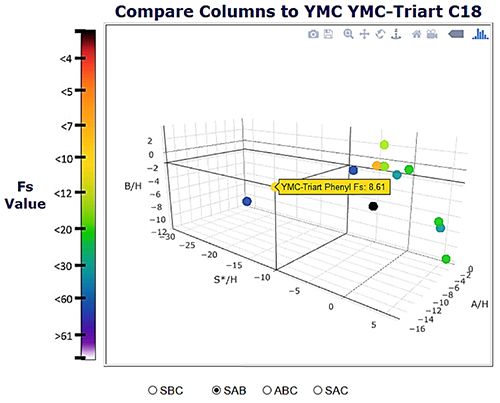
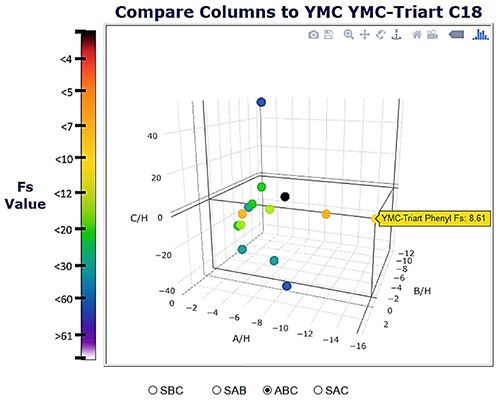
Figure 2: Demonstration of the use of 3D models to identify the selectivity characteristics of the YMC Triart Phenyl column grouped by various parameters which are expected to dominate for various broad analyte classifications.
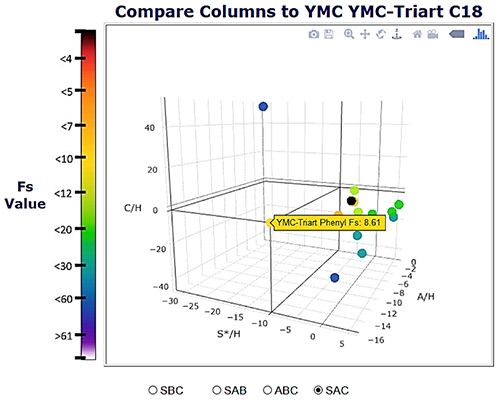
Figure 3 shows a similar investigation for small basic analytes on various YMC Triart Stationary phases – that is, examining the various column selectivity’s when dealing with a particular analyte classification. It should be noted that the color coding and Fs values show the column similarity according the Hydrophobic Interaction Model scaling system.
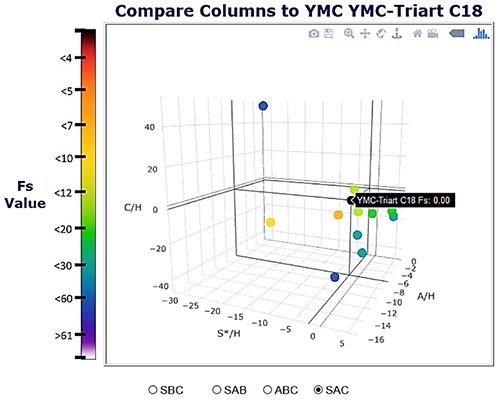
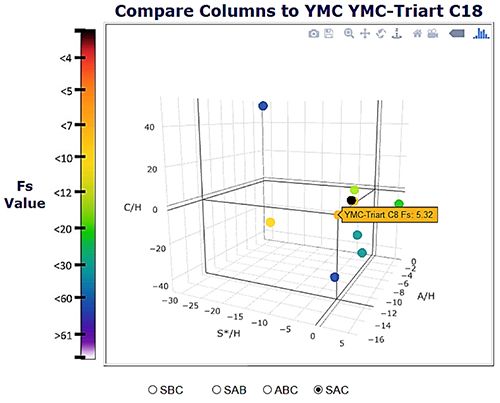
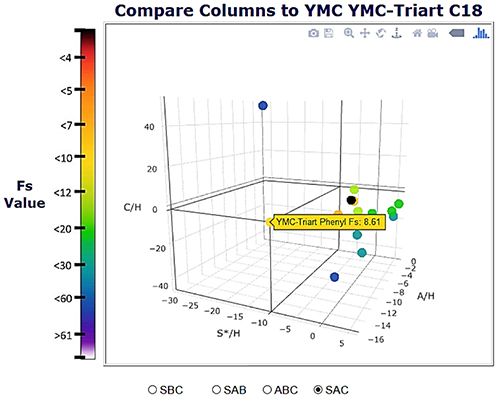
Figure 3: Demonstration of the use of 3D models to compare the selectivity of a range of YMC Triart column stationary phases with analytes of different broad classification.
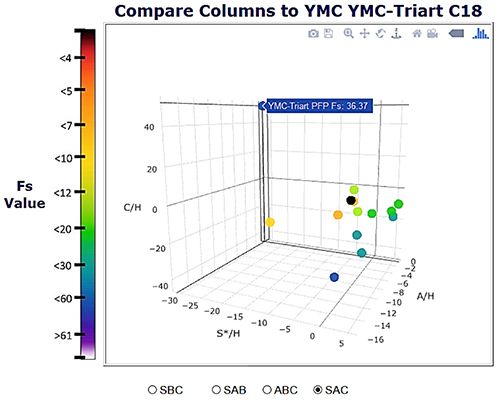
From Figure 3 we can see the various differences in selectivity between the Triart C18 column and the other phases available in this column range when analyzing small ionizable basic compounds. It should be noted that the 3D models can be rotated to aid the comparison of the columns according to each parameter which is being plotted.
Figure 4 shows the separation of such analytes as well as a range of other analytes which we will interpret below.
Figure 4: Separations of a number of test probe compounds, useful in providing correlation between experimental data and information from column selectivity characteristics databases.
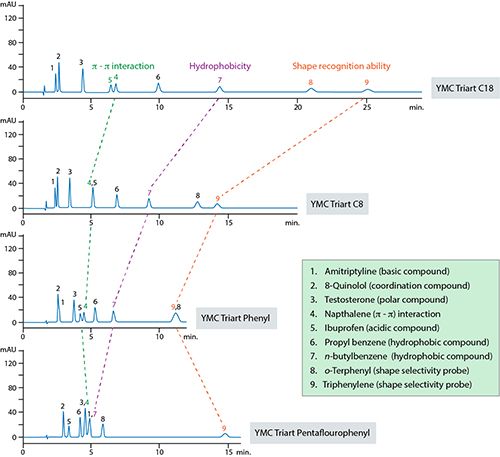
(CLICK IMAGE TO ENLARGE)
As a broad interpretation from Figures 3 and 4, for small ionizable basic analytes, one might expect lower interactions due to hydrogen bond and electrostatic interactions (separation between analytes 1 and 3) and altered shape selectivity (analytes 8,9) for Triart C8 versus Triart C18.
From the 3D plots of column SAC measurements, we would expect increased interactions with ionised analytes compared to non-ionized analytes when comparing Triart C18 columns to Triart Phenyl columns (analytes 1,3). Further, the Phenyl column should show different shape selectivity (analyte pair 8, 9).
Based on the large differences between A and C values, the pentafluorophenyl phase will show distinctly different interactions (selectivity) between ionized and non-ionized analytes compared to the C18 phase (analytes 1,3) and enhanced (or significantly different) shape selectivity characteristics (analytes 8,9).
From the 3d plots, one might expect decreasing retention for acidic analytes (as defined by lower B and C values) as we move from C18 to C8 and from Phenyl to PFP phases which is borne out by the retention of compound 5.
While the 3D plots are not currently able to show the selectivity differences due to the degree of π-π interaction between the analyte and stationary phase, it is recognized that the extent of π-π interaction changes in the order PFP>Phenyl>Alkyl, which again is broadly borne out by the behavior of compound 4 in Figure 4.
In summary, a useful method for comparing relative column selectivity for broad analyte categories has been demonstrated and it is this ability to correlate various column selectivity characteristics with the broad analyte classification via the use of 3D box plots for SAC, SBC etc. which is particularly useful as it highlights important selectivity drivers for the analyte classification. While this is still not the Nirvana of choosing the correct column for our separation, it does deliver some of the benefits of codification of the relationships between column and analyte characteristics and has, in our hands, proved to be very useful for column selection and comparison and to help rationalize the result of method development experiments.
References
âK. Kimata, K. Iwaguchi, S. Onishi, K. Jinno, R. Eksteen, K. Hosoya, M. Arki, and N. Tanaka, J. Chromatogr. Sci. 27, 721 (1989).
M.R. Euerby and P. Petersson, J. Chromatogr. A 994, 13–36 (2003).
M.R. Euerby and P. Petersson, J. Chromatogr. A 1088, 1–15 (2005).
M.R. Euerby and P. Petersson, J. Chromatogr. A 1154, 138–151 (2007).
N.S. Wilson, M.D. Nelson, J.W. Dolan, L.R. Snyder, R.G. Wolcott, and P.W. Carr, J. Chromatogr. A 961, 171–193 (2002).
J.W. Dolan, A. Maule, D. Bingley, L. Wrisley, C.C. Chand, M. Angod, C. Lunte, R. Krisko, J.M. Winston, B.A. Homeier, D.V. McCalley, and L.R. Snyder, J. Chromatogr. A 1057, 59–74 (2004).
L.R. Snyder, A. Maule, A. Heebsh, R. Cuellar, S. Paulson, J. Carrano L. Wrisley, C.C. Chan, N. Pearson, J.W. Dolan, and J.J. Gilroy, J. Chromatogr. A 1057, 49–57 (2004).
N.S. Wilson, M.D. Nelson, J.W. Dolan, L.R. Snyder, R.G. Wolcott, and P.W. Carr, J. Chromatogr. A 961, 195–215 (2002).
Column Selection for HPLC Method Development:
http://www.chromatographyonline.com/column-selection-hplc-method-development

Tony Taylor is the technical director of Crawford Scientific and ChromAcademy. He comes from a pharmaceutical background and has many years research and development experience in small molecule analysis and bioanalysis using LC, GC, and hyphenated MS techniques. Taylor is actively involved in method development within the analytical services laboratory at Crawford Scientific and continues to research in LC-MS and GC-MS methods for structural characterization. As the technical director of the CHROMacademy, Taylor has spent the past 12 years as a trainer and developing online education materials in analytical chemistry techniques.
The LCGC Blog: Historical (Analytical) Chemistry Landmarks
November 1st 2024The American Chemical Society’s National Historic Chemical Landmarks program highlights sites and people that are important to the field of chemistry. How are analytical chemistry and separation science recognized within this program?
